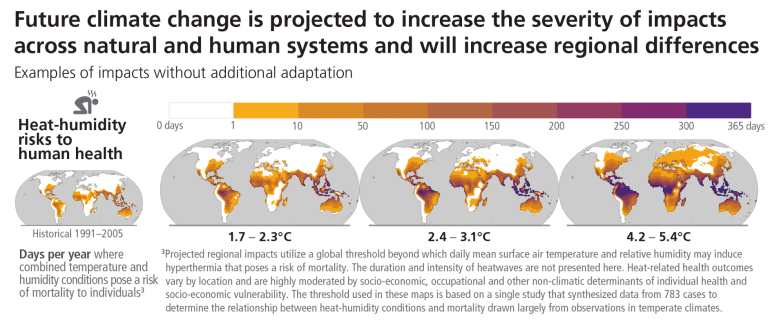Climate change and heatwaves
According to the Sixth Assessment Report of the Intergovernmental Panel on Climate Change (IPCC), human-caused climate change has increased the frequency and intensity of heatwaves since the 1950s and additional warming will further increase their frequency and intensity.
The IPCC’s Sixth Assessment Report found human influence has likely increased the chance of compound extreme events since the 1950s, including the frequency of concurrent heatwaves and droughts on the global scale.
With every additional increment of global warming, changes in extremes continue to become larger. For example, every additional 0.5°C of global warming causes clearly discernible increases in the intensity and frequency of temperature extremes, including heatwave intensity, frequency and duration.
Heatwaves amplify the impact of drought, increase wildfire behaviour, hazardous smoke, water insecurity, power shortages and agricultural losses, which causes significant damage to communities around the world. Globally, population exposure to heatwaves will continue to increase with additional warming, with strong geographical differences in heat-related mortality affecting those with the least resources without additional interventions and adaptation.
Main findings include:
- Those that have contributed least to climate change are the most vulnerable.
- Heatwaves increase risks to food security in vulnerable regions.
- Losses of local plant and animal populations have been widespread, many associated with large increases in hottest yearly temperatures and heatwave events.
- Increasing temperatures and heatwaves have increased mortality and morbidity, with impacts that vary by age, gender, urbanisation and socioeconomic factors.
- Highly vulnerable groups experiencing health impacts from heat stress include anyone working outdoors and, especially, those doing outdoor manual labour (e.g., construction work, farming). Potential hours of work lost due to heat have increased significantly over the past two decades. Some regions are already experiencing heat stress conditions at or approaching the upper limits of labour productivity.
- Heatwaves in cities are often exacerbated by the ‘urban heat island’ effect.
- Rapid urbanisation and lack of climate-sensitive planning, along with continuing threats from urban heat islands, is increasing the vulnerability of marginalised urban populations and key infrastructure to climate change.
- Pests, weeds and disease occurrence and distribution are projected to increase with global warming, amplified by climate change induced extreme events (e.g., droughts, floods, heatwaves and wildfires), with negative consequences for ecosystem health, food security, human health and livelihoods.

Further reading: AR6 Synthesis Report: Climate Change 2023 (IPCC)

